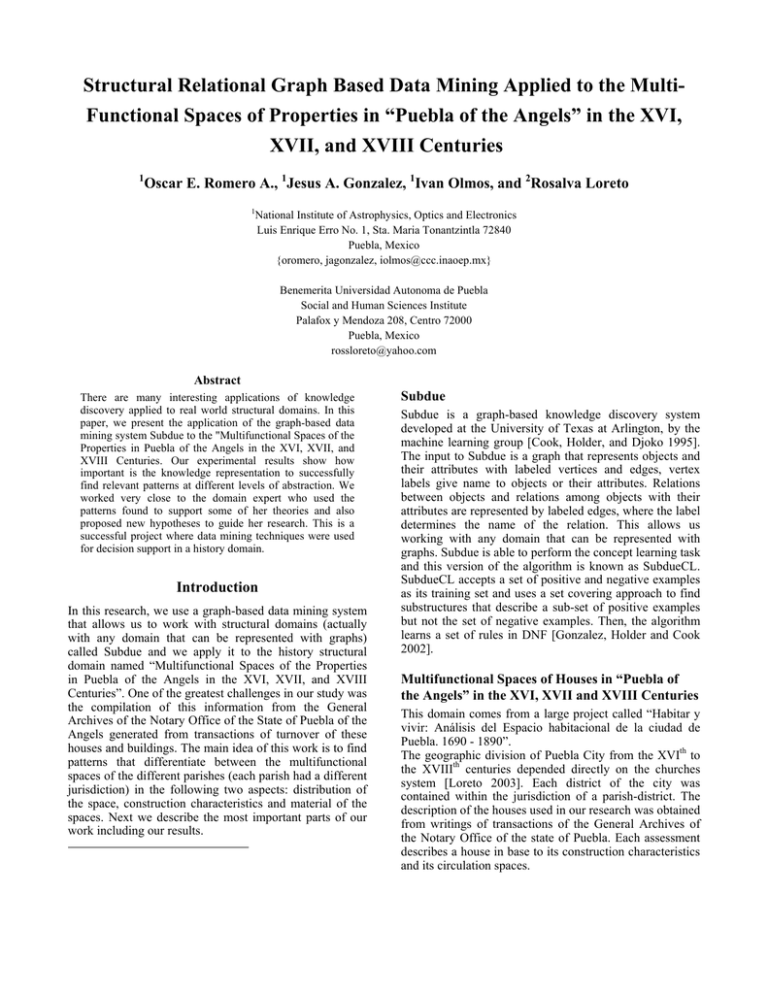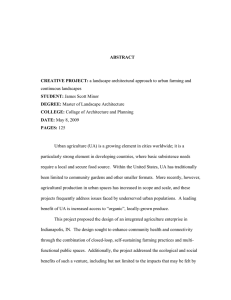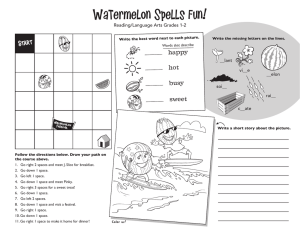Structural Relational Graph Based Data Mining Applied to the Multi-
advertisement

Structural Relational Graph Based Data Mining Applied to the MultiFunctional Spaces of Properties in “Puebla of the Angels” in the XVI,
XVII, and XVIII Centuries
1
Oscar E. Romero A., 1Jesus A. Gonzalez, 1Ivan Olmos, and 2Rosalva Loreto
1
National Institute of Astrophysics, Optics and Electronics
Luis Enrique Erro No. 1, Sta. Maria Tonantzintla 72840
Puebla, Mexico
{oromero, jagonzalez, iolmos@ccc.inaoep.mx}
Benemerita Universidad Autonoma de Puebla
Social and Human Sciences Institute
Palafox y Mendoza 208, Centro 72000
Puebla, Mexico
rossloreto@yahoo.com
Abstract
There are many interesting applications of knowledge
discovery applied to real world structural domains. In this
paper, we present the application of the graph-based data
mining system Subdue to the "Multifunctional Spaces of the
Properties in Puebla of the Angels in the XVI, XVII, and
XVIII Centuries. Our experimental results show how
important is the knowledge representation to successfully
find relevant patterns at different levels of abstraction. We
worked very close to the domain expert who used the
patterns found to support some of her theories and also
proposed new hypotheses to guide her research. This is a
successful project where data mining techniques were used
for decision support in a history domain.
Introduction
In this research, we use a graph-based data mining system
that allows us to work with structural domains (actually
with any domain that can be represented with graphs)
called Subdue and we apply it to the history structural
domain named “Multifunctional Spaces of the Properties
in Puebla of the Angels in the XVI, XVII, and XVIII
Centuries”. One of the greatest challenges in our study was
the compilation of this information from the General
Archives of the Notary Office of the State of Puebla of the
Angels generated from transactions of turnover of these
houses and buildings. The main idea of this work is to find
patterns that differentiate between the multifunctional
spaces of the different parishes (each parish had a different
jurisdiction) in the following two aspects: distribution of
the space, construction characteristics and material of the
spaces. Next we describe the most important parts of our
work including our results.
Subdue
Subdue is a graph-based knowledge discovery system
developed at the University of Texas at Arlington, by the
machine learning group [Cook, Holder, and Djoko 1995].
The input to Subdue is a graph that represents objects and
their attributes with labeled vertices and edges, vertex
labels give name to objects or their attributes. Relations
between objects and relations among objects with their
attributes are represented by labeled edges, where the label
determines the name of the relation. This allows us
working with any domain that can be represented with
graphs. Subdue is able to perform the concept learning task
and this version of the algorithm is known as SubdueCL.
SubdueCL accepts a set of positive and negative examples
as its training set and uses a set covering approach to find
substructures that describe a sub-set of positive examples
but not the set of negative examples. Then, the algorithm
learns a set of rules in DNF [Gonzalez, Holder and Cook
2002].
Multifunctional Spaces of Houses in “Puebla of
the Angels” in the XVI, XVII and XVIII Centuries
This domain comes from a large project called “Habitar y
vivir: Análisis del Espacio habitacional de la ciudad de
Puebla. 1690 - 1890”.
The geographic division of Puebla City from the XVIth to
the XVIIIth centuries depended directly on the churches
system [Loreto 2003]. Each district of the city was
contained within the jurisdiction of a parish-district. The
description of the houses used in our research was obtained
from writings of transactions of the General Archives of
the Notary Office of the state of Puebla. Each assessment
describes a house in base to its construction characteristics
and its circulation spaces.
Knowledge Representation
We tested with three alternative representations: 1.
circulation spaces, 2. circulation spaces + transitory spaces,
3. circulation spaces + transitory spaces + construction
characteristics. An example with part of our graph-based
representation of a property is shown in figure 1a. In this
figure we can see the circulation sub-spaces: “street”,
“tailgate”, “yard”, “storeroom”, “stairs”, and “hall” and the
connections between them (there exists a door between
“street” and “tailgate”, “yard” and “storeroom” and an
open connection in all the other cases). Double contour in
the vertices describing spaces represents the second floor.
We can also include transitory spaces (internal spaces such
as a door connecting two main spaces) as we can see in
figure 1b. Finally, we can include all the information about
a property that describes not only the main and transitory
spaces but also their construction characteristics. An
example of this representation is shown in figure 1c.
a)
b)
c)
Figure 1. Knowledge Representations. a) Circulation spaces
between the objects, street, tailgate, yard, stairs, hall and
storeroom. b) Transitory spaces between the spaces street,
tailgate, yard and storeroom from figure 1a. c) The yard space
(from figure 1a) and its construction characteristics.
Methodology
The experiments were made with the knowledge
representations presented before. The properties
information (or houses examples) was divided in three
subgroups as follows: District of Analco 49 assessments,
District of San Sebastian 51 assessments, Districts of
Analco and San Sebastian, 100 assessments. We ran
Subdue with each of the representations for each subset of
properties. We also tested SubdueCL (with the three
knowledge representations) using the Analco district as
positive examples and San Sebastian as negative examples.
We then switched Analco to be our negative examples and
San Sebastian to be the positive examples. Some of the
results of these tests are presented in the next section.
Results
In this section we present the most significant results for
the set of experiments mentioned in the previous section.
Figure 2a shows one of the patterns found in the district of
Analco using representation 1 with Subdue. In figure 2b
we can observe one of the transitory patterns found in the
district of San Sebastian using representation 2 with
Subdue. The substructure shown in figure 2c is a pattern
that reflects some of the construction characteristics of the
properties in the district of Analco (this pattern was found
using representation 3 with Subdue). This is a very
significant pattern for our history domain because it
reflects the importance that wood doors had as means of
protection of the property (the door of the tailgate) and as
means of privacy between different subspaces in the
property. Historians were sure that security was not
important by that time and this pattern shows the opposite
(we found a similar pattern with windows).
a)
b)
c)
Figure 2. Subdue Results. a) Circulation pattern found at the
Analco parish. b) Transitory patterns found at the San Sebatian
parish. c) Construction characteristics of doors found at the
Analco parish.
We also ran SubdueCL with representation three
(construction characteristics) using data from the Analco
district as positive examples and data from the San
Sebastian district as negative examples. We performed a
10-Fold cross validation to see how well the model
distinguishes between the properties that belong to the
Analco and San Sebastian parishes. In this test we obtained
a 94.85 % of accuracy. From the history point of view,
these substructures help us to distinguish the circulation
and construction patterns between the two parishes. The
differences are due to the ethnic groups living in them and
also to their living conditions.
Conclusion
The different knowledge representations used in this work,
helped to find significant patterns at different levels of
abstraction by means of Subdue. These patterns are being
used by our history domain expert to confirm her
hypotheses and to generate new theories about how people
was organized to populate new areas.
Acknowledges
This project is supported by CONACYT under project
number 38257H.
References
Cook, Diane J., Holder, Lawrence B. and Djoko, Surnjani, 1995.
Knowledge discovery from Structural Data. Journal of Intelligent
Information Systems. Vol. 5, no. 3, pages 229-245.
Gonzalez, Jesus; Holder, Lawrence B; and Cook, Diane J. 2002
“Graph-Based Relational Concept Learning”, Proceedings of the
Nineteenth International Conference on Machine Learning.
Loreto Lopez, Rosalva, 2003. La Casa, la Vivienda y el Espacio
Doméstico en la Puebla de los Angeles del Siglo XVIII. Mexico.




